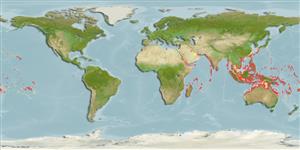Common names from other countries
Classification / Names / Names
Namen | Synonyme | Catalog of Fishes (gen., sp.) | ITIS | CoL | WoRMS
Environment: milieu / climate zone / depth range / distribution range
Ökologie
Riff-verbunden; tiefenbereich 0 - 40 m (Ref. 847). Tropical; 36°N - 31°S, 32°E - 137°W (Ref. 847)
Indo-Pacific.
Length at first maturity / Size / Gewicht / Alter
Maturity: Lm ? range ? - ? cm
Found along the neritic zone, in reef areas (Ref. 97241), particularly in upper reef slopes, especially those of fringing reefs, in turbid water away from wave action and lagoons (Ref 98471). A predatory carnivore (Ref. 97241). Has a high bleaching level and moderate to high estimated mortality in Palau (Ref. 66144).
Life cycle and mating behavior
Geschlechtsreife | Fortpflanzung | Ablaichen | Eier | Fecundity | Larven
Members of the class Anthozoa are either gonochoric or hermaphroditic. Mature gametes are shed into the coelenteron and spawned through the mouth. Life cycle: The zygote develops into a planktonic planula larva. Metamorphosis begins with early morphogenesis of tentacles, septa and pharynx before larval settlement on the aboral end (Ref. 833).
Nemenzo, F. Sr. 1986. (Ref. 910)
IUCN Rote Liste Status (Ref. 130435)
CITES Status (Ref. 108899)
Not Evaluated
Nutzung durch Menschen
| FishSource |
Tools
Mehr Information
Alter/Größe
Wachstum
Länge-Gewicht
Länge-Länge
Morphologie
Larven
Dichte
Internet Quellen
Estimates based on models
Preferred temperature
(Ref.
115969): 24.8 - 29, mean 28 (based on 1078 cells).
Preiskategorie
Unknown.
